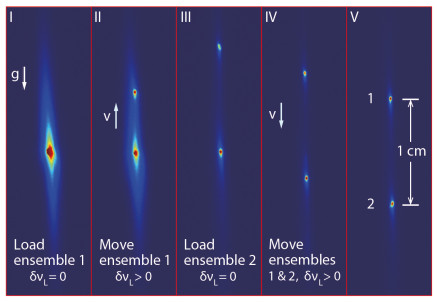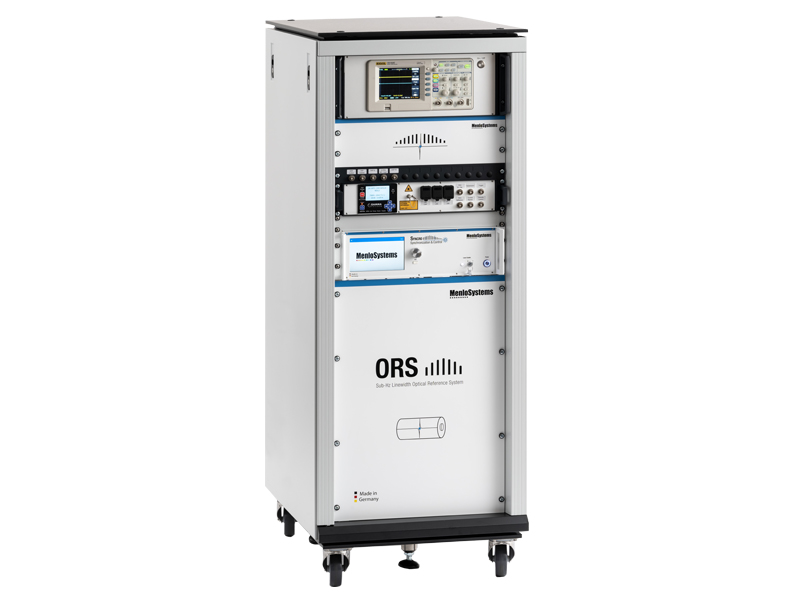Menlo Systems' product:
Clock pairs for higher stability
Researchers from the University of Wisconsin-Madison and University of California Berkeley, USA, have realized a new kind of multiplexed optical atomic clock for high-precision frequency measurements in a portable format. They used Menlo Systems’ ORS Ultrastable Laser System for the clock read-out.

Figure 1: Schematics of the multiplexed optical lattice clock
Artificial devices typically lag behind the precision nature has to offer. Atoms of a specific element in identical environments, cooled to eliminate motion and isolated from interacting with each other, have identical properties and are therefore ideally suited to serve as the most accurate universal oscillators for timekeeping. The high frequencies of optical atomic transitions offer an unprecedented level of precision in timekeeping and metrology, but in order to access this high precision, we rely on lasers tuned to the transition frequency. However, their frequency instability ultimately limits the precision of the read-out.
A team led by Shimon Kolkowitz from the University of Wisconsin-Madison and University of California Berkeley, USA, significantly reduced the deteriorating effect of laser instability by comparing pairs of strontium (Sr) optical clocks “multiplexed” within a single optical lattice. By replacing the atom-laser comparison with an atom-atom comparison, a 270-fold gain in coherence time was demonstrated, leading to a significantly improved precision of clock comparison measurement that is equivalent to measuring differences in the rates of the two clocks at the level of 1 second in 300 billion years - about 20 times the age of the universe [1]. This differential clock performance enables applications such as gravitational wave or dark matter detection, and provides sufficient sensitivity to measure relativistic effects in table-top experiments, as was recently demonstrated by the same group in subsequent work [2].
In their work, the team used Menlo Systems’ portable ORS Ultrastable Laser System as their clock laser. The new platform, in combination with a rack-mounted commercial laser, has implications for the wide applicability of high-precision instrumentation, in particular for use in remote places with limited access. Most notably, the level of precision competes with the best optical clocks in scientific laboratory setups.
The natural linewidth of an atomic transition is a measure of its coherence time. Optical atomic clocks make use of ultranarrow optical transitions with highly defined transition frequencies to exploit the long coherence time for high-precision measurements, as manifested in the time-energy uncertainty principle. However, by simply increasing the light-matter interaction time, accumulated systematic errors and noise will counteract measurement precision. Here, Ramsey spectroscopy evolved as the gold-standard to minimize such disturbing effects. In this technique, two short interaction times are separated by a period of non-interaction, in which the initially prepared quantum state evolves until it is interrogated by the second interaction event. The resulting Ramsey fringes provide a clue as to how the interrogating laser frequency can be tuned to exactly match the resonance of the atomic transition, with the fringes’ envelope corresponding to the transition’s absorption linewidth.
Determining the absolute frequency of the optical clock transition is, however, susceptible to the instability of the interrogating laser. By comparing two or more optical clocks, the effect of the contributing instability is mitigated, and the overall instability of the comparison is fundamentally limited by the so-called quantum projection noise, where increasing the number of atoms, the interrogation time, and the averaging time acts favorably on the end result. Nevertheless, state-of-the-art instability measurements from comparisons using high-end clock-lasers with mHz-linewidth suggest that the effect of the laser instability may still play a role in the measurement.

Figure 2: Camera images of the strontium atom ensembles taken during the loading stages of the clock lattice
Shimon Kolkowitz’s team developed a novel approach to differential clock comparisons [1]. Instead of synchronously comparing individual clocks or isolated sub-ensembles in clock arrangements, they simultaneously interrogated pairs of larger, spatially-separated ensembles of Sr atoms within a ‘multiplexed’ optical lattice clock (OLC), located in a shallow, vertically oriented one-dimensional (1D) optical lattice (Fig. 1).
The team realized a movable optical lattice along the 1D lattice axis by variably detuning the retro lattice laser. This way, they administered the loading of different lattice sites by Sr atoms located in a magneto-optical trap (MOT) at the center of the lattice beam waist (Fig. 2). The resulting “multiplexed” lattice consisted of up to six ensembles of 500 to 2400 Sr atoms each, with tunable separation from <1 mm to >1 cm.
The simultaneous clock pair comparison uses a shared clock laser, with the read-out performed in parallel. Menlo Systems’ ORS Ultrastable Laser with a linewidth of <1 Hz served as the clock laser. The ORS uses an optical reference cavity manufactured from ultra-low expansion glass with vanishing expansion coefficient at room temperature. The linewidth is orders of magnitude larger compared to high-end laboratory set-up systems using cryogenic silicon cavities. However, the novel platform design, which compares the atom-atom coherence times of two interrogated ensembles, leads to a 270-fold improvement over the atom-laser coherence time. This translates to a relative statistical measurement uncertainty of 8.9 x 10-20 in the frequency difference between two ensembles after 3.3 h of averaging, competitive with the best levels of uncertainty demonstrated with cryogenic cavity setups.
The multiplexed OLC technique further proved to be scalable by the demonstration of a miniature network of six clocks that the researchers interrogated simultaneously, providing 15 unique differential comparisons at once. Each comparison averaged down to a relative statistical uncertainty of 5 x 10-19 after one hour. Such an experiment allows a sensitive analysis of systematic effects within the lattice, such as thermal gradients, or residual electric or magnetic field gradients and their corresponding contributions to frequency uncertainty.
Furthermore, the researchers demonstrated that the multiplexed clock platform also supports precision isotope shift measurements by loading different stable Sr isotopes with narrow-line clock transitions into different lattice sites, aiding the search for new physics beyond the Standard Model.
In conclusion, the novel differential clock comparison approach, with spatially-resolved atom ensembles in a 1D-optical lattice, demonstrates that state-of-the-art measurement precision can be achieved using a commercially-available, portable ultrastable laser system. Not only does it encourage in-field applications, but it enables table-top solutions for the measurement of relativistic effects on the sub-centimeter scale. As direct evidence of this, in a subsequent work using an array of 5 atomic ensembles evenly spaced across a 1-cm height difference, the group measured a fractional frequency gradient consistent with the expected gravitational-redshift gradient, demonstrating a sensitivity of this novel approach to the effects of general relativity due to millimeter-scale height changes on the Earth surface [2].
Furthermore, increasing the degree of multiplexing offers a new tool for the characterization of the world’s most accurate optical clocks for systematic effects, and allows the analysis of different stable isotopes. Recently, the group also demonstrated the efficacy of the multiplexing technique for further reducing the absolute instability of single optical clock by using a phase estimation approach in individually controlled atomic ensembles [3], which could reduce the stability requirements on clock lasers for applications involving portable clocks.
Together with the work of the team led by Jun Ye at JILA, USA, comparing subregions of an mm-scale atomic ensemble in a vertical lattice [4], which has been published in parallel, the presented work will have implications on timekeeping and related metrological questions, as well as on quantum science in general.
Author: Patrizia Krok
Original publications:
[1] X. Zheng, J. Dolde, V. Lochab, B. N. Merriman, H. Li, and Sh. Kolkowitz:
Differential clock comparisons with a multiplexed optical lattice clock;
Nature Vol. 602, p. 425 (2022)
DOI: 10.1038/s41586-021-04344-y
[2] X. Zheng, J. Dolde, M. C. Cambira, H. M. Lim, and Sh. Kolkowitz:
A lab-based test of the gravitational redshift with a miniature clock network;
Nature Communications Vol. 14, Article number: 4886 (2023)
DOI: 10.1038/s41467-023-40629-8
[3] X. Zheng, J. Dolde, and Sh. Kolkowitz:
Reducing the Instability of an Optical Lattice Clock Using Multiple Atomic Ensembles;
Physical Review X, Vol. 14, 011006 (2024)
DOI: 10.1103/PhysRevX.14.011006
[4] T. Bothwell, C. J. Kennedy, A. Aeppli, D. Kedar, J. M. Robinson, E. Oelker, A. Staron, and J. Ye:
Resolving the gravitational redshift across a millimetre-scale atomic sample;
Nature Vol. 602, p. 420 (2022)
DOI: 10.1038/s41586-021-04349-7
